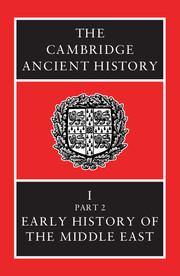Book contents
- Frontmatter
- Contents
- List of Maps
- List of Tables
- List of Text-figures
- Preface
- CHAPTER XI THE EARLY DYNASTIC PERIOD IN EGYPT
- CHAPTER XII THE LAST PREDYNASTIC PERIOD IN BABYLONIA
- CHAPTER XIII THE CITIES OF BABYLONIA
- CHAPTER XIV THE OLD KINGDOM IN EGYPT AND THE BEGINNING OF THE FIRST INTERMEDIATE PERIOD
- CHAPTER XV PALESTINE IN THE EARLY BRONZE AGE
- CHAPTER XVI THE EARLY DYNASTIC PERIOD IN MESOPOTAMIA
- CHAPTER XVII SYRIA BEFORE 2200 B.C.
- CHAPTER XVIII ANATOLIA, c. 4000–2300 b.c.
- CHAPTER XIX THE DYNASTY OF AGADE AND THE GUTIAN INVASION
- CHAPTER XX THE MIDDLE KINGDOM IN EGYPT: INTERNAL HISTORY FROM THE RISE OF THE HERACLEOPOLITANS TO THE DEATH OF AMMENEMES III
- CHAPTER XXI SYRIA AND PALESTINE c. 2160–1780 b.c.
- CHAPTER XXII BABYLONIA, c. 2120–1800 B.C.
- CHAPTER XXIII PERSIA, c. 2400–1800 B.C.
- CHAPTER XXIV (a) ANATOLIA, c. 2300–1750 B.C.
- CHAPTER XXIV(b) ANATOLIA IN THE OLD ASSYRIAN PERIOD
- CHAPTER XXV ASSYRIA, c. 2600–1816 B.C.
- CHAPTER XXVI(a) GREECE, CRETE, AND THE AEGEAN ISLANDS IN THE EARLY BRONZE AGE
- CHAPTER XXVI(b) CYPRUS IN THE EARLY BRONZE AGE
- CHAPTER XXVII IMMIGRANTS FROM THE NORTH
- BIBLIOGRAPHIES
- Chronological Tables
- Index to Maps
- General Index
- Map 6. Babylonia and Western Persia.
- Map 12. Early Bronze Age sites in Greece and the Aegean Islands.
- Map 16. Map to illustrate movements of northern peoples in the third to first millennia B.C.
- References
CHAPTER XIX - THE DYNASTY OF AGADE AND THE GUTIAN INVASION
Published online by Cambridge University Press: 28 March 2008
- Frontmatter
- Contents
- List of Maps
- List of Tables
- List of Text-figures
- Preface
- CHAPTER XI THE EARLY DYNASTIC PERIOD IN EGYPT
- CHAPTER XII THE LAST PREDYNASTIC PERIOD IN BABYLONIA
- CHAPTER XIII THE CITIES OF BABYLONIA
- CHAPTER XIV THE OLD KINGDOM IN EGYPT AND THE BEGINNING OF THE FIRST INTERMEDIATE PERIOD
- CHAPTER XV PALESTINE IN THE EARLY BRONZE AGE
- CHAPTER XVI THE EARLY DYNASTIC PERIOD IN MESOPOTAMIA
- CHAPTER XVII SYRIA BEFORE 2200 B.C.
- CHAPTER XVIII ANATOLIA, c. 4000–2300 b.c.
- CHAPTER XIX THE DYNASTY OF AGADE AND THE GUTIAN INVASION
- CHAPTER XX THE MIDDLE KINGDOM IN EGYPT: INTERNAL HISTORY FROM THE RISE OF THE HERACLEOPOLITANS TO THE DEATH OF AMMENEMES III
- CHAPTER XXI SYRIA AND PALESTINE c. 2160–1780 b.c.
- CHAPTER XXII BABYLONIA, c. 2120–1800 B.C.
- CHAPTER XXIII PERSIA, c. 2400–1800 B.C.
- CHAPTER XXIV (a) ANATOLIA, c. 2300–1750 B.C.
- CHAPTER XXIV(b) ANATOLIA IN THE OLD ASSYRIAN PERIOD
- CHAPTER XXV ASSYRIA, c. 2600–1816 B.C.
- CHAPTER XXVI(a) GREECE, CRETE, AND THE AEGEAN ISLANDS IN THE EARLY BRONZE AGE
- CHAPTER XXVI(b) CYPRUS IN THE EARLY BRONZE AGE
- CHAPTER XXVII IMMIGRANTS FROM THE NORTH
- BIBLIOGRAPHIES
- Chronological Tables
- Index to Maps
- General Index
- Map 6. Babylonia and Western Persia.
- Map 12. Early Bronze Age sites in Greece and the Aegean Islands.
- Map 16. Map to illustrate movements of northern peoples in the third to first millennia B.C.
- References
Summary
THE REIGN OF SARGON
With the appearance of this imposing figure, vast but dim to later generations of Babylonians hardly less than to us, the historical memory of the people was enriched with its most abiding treasure. Yet the written tradition, so far as it is at present available to us, does scant justice to a king who could not only achieve greatness but could record it for posterity more clearly than any before and most after him. The inscriptions of Sargon must have been numerous and their remains show that they were informative and detailed as to his warlike and religious, possibly even his civil, transactions. With a different language something of a new spirit came into the records, and seemed for a time to overcome the historical reticence which is so disappointingly manifest in other not inglorious periods of the nation's experience. The inscriptions are mostly lost or not yet recovered, though a few remain in copies made by scribes who perused the statues and trophies laid up in the great central shrine at Nippur. The Sumerian king-list spares but two or three remarks upon the founder himself and relapses into its customary tale of names and numbers for the rest of the Dynasty of Agade; and all else is anecdote preserved and perhaps adapted for special ends.
A miraculous or a mysterious origin is essential to superhuman characters, and Sargon was the first to show that the taste of the ancient eastern peoples was to be for the latter. Like several notable successors he had, and did not disguise, an obscure birth and a humble beginning.
- Type
- Chapter
- Information
- The Cambridge Ancient History , pp. 417 - 463Publisher: Cambridge University PressPrint publication year: 1971
References
- 9
- Cited by

